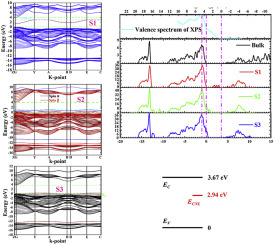当前位置:
X-MOL 学术
›
Mater. Sci. Semicond. Proc.
›
论文详情
Our official English website, www.x-mol.net, welcomes your
feedback! (Note: you will need to create a separate account there.)
Firstprinciple investigation of the surface states of tin dioxide (100)
Materials Science in Semiconductor Processing ( IF 4.2 ) Pub Date : 2020-07-01 , DOI: 10.1016/j.mssp.2020.105020 Peng Tang , Shengqiang Ren , Jingquan Zhang , Lili Wu , Wei Li , Bing Li , Guanggen Zeng , Wenwu Wang , Cai Liu , Lianghuan Feng
Materials Science in Semiconductor Processing ( IF 4.2 ) Pub Date : 2020-07-01 , DOI: 10.1016/j.mssp.2020.105020 Peng Tang , Shengqiang Ren , Jingquan Zhang , Lili Wu , Wei Li , Bing Li , Guanggen Zeng , Wenwu Wang , Cai Liu , Lianghuan Feng

|
Abstract As an important functional film, tin dioxide (SnO2) was widely used in the communities of gas sensors as well as solar cells. SnO2 (110) and (100) surfaces were thought to be stable, and both could be easily obtained by common preparation method. The characteristics of SnO2 surface were critical to the performance of devices when it was applied in solar cells, and the SnO2 (100) surface had not been understood explicitly. A series of SnO2 (100) surface models with different terminal atoms were built in this work and calculated by density functional theory (DFT) with GGA + U. SnO2 (100) surfaces with different terminal atoms exhibited distinctly different surface states. Basically, these surface states mainly originated from the terminal atoms, and they extended to the tenth monoatomic layer. SnO2 (100) surface terminated with single monolayer of O atoms was the structure with the least surface states. The real surface of SnO2 was thought to be consisting of O terminal atoms mostly. The charge neutral level of SnO2 (100) surface was thought to be 2.94 eV above the valence band.
中文翻译:

二氧化锡表面状态的第一性原理研究(100)
摘要 二氧化锡(SnO2)作为一种重要的功能薄膜,被广泛应用于气体传感器和太阳能电池领域。SnO2(110)和(100)表面被认为是稳定的,两者都可以通过普通的制备方法轻松获得。SnO2 表面的特性在将其应用于太阳能电池时对器件的性能至关重要,而 SnO2 (100) 表面尚未得到明确理解。在这项工作中建立了一系列具有不同末端原子的 SnO2 (100) 表面模型,并通过密度泛函理论 (DFT) 计算了 GGA + U。具有不同末端原子的 SnO2 (100) 表面表现出明显不同的表面状态。基本上,这些表面态主要起源于末端原子,并扩展到第十单原子层。SnO2 (100) 表面终止于单层 O 原子是具有最少表面态的结构。SnO2 的真实表面被认为主要由 O 端原子组成。SnO2 (100) 表面的电荷中性水平被认为比价带高 2.94 eV。
更新日期:2020-07-01
中文翻译:

二氧化锡表面状态的第一性原理研究(100)
摘要 二氧化锡(SnO2)作为一种重要的功能薄膜,被广泛应用于气体传感器和太阳能电池领域。SnO2(110)和(100)表面被认为是稳定的,两者都可以通过普通的制备方法轻松获得。SnO2 表面的特性在将其应用于太阳能电池时对器件的性能至关重要,而 SnO2 (100) 表面尚未得到明确理解。在这项工作中建立了一系列具有不同末端原子的 SnO2 (100) 表面模型,并通过密度泛函理论 (DFT) 计算了 GGA + U。具有不同末端原子的 SnO2 (100) 表面表现出明显不同的表面状态。基本上,这些表面态主要起源于末端原子,并扩展到第十单原子层。SnO2 (100) 表面终止于单层 O 原子是具有最少表面态的结构。SnO2 的真实表面被认为主要由 O 端原子组成。SnO2 (100) 表面的电荷中性水平被认为比价带高 2.94 eV。











































 京公网安备 11010802027423号
京公网安备 11010802027423号